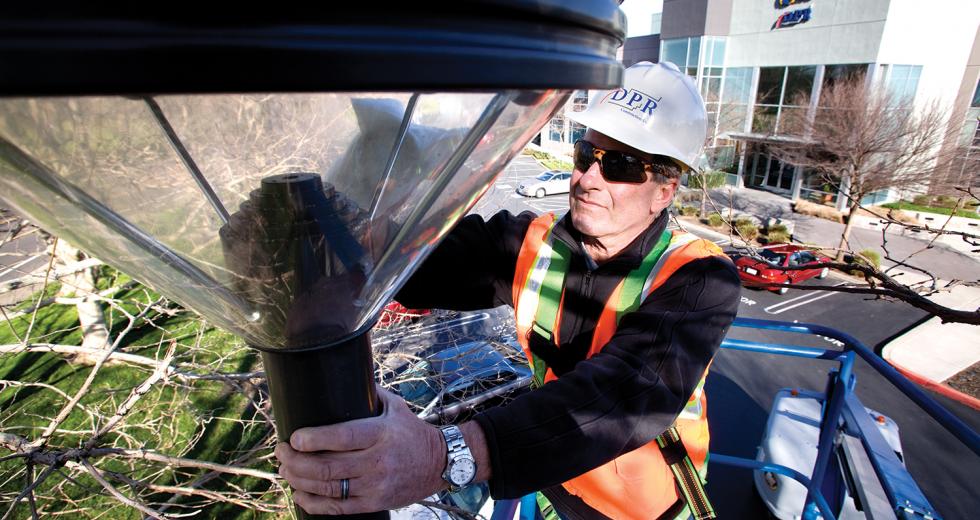Sometimes, a building’s security needs can pop up unexpectedly during the design process. Nils Blomquist, preconstruction manager for DPR Construction Inc. in Sacramento, was working on the renovation of a data center that would store patient records for Kaiser Permanente. The client’s security concerns initially seemed far-fetched.
“‘What happens if a car drives off the road, drives down the hill, goes across the parking lot, jumps the curb and drives into the building,’” Blomquist remembers a Kaiser representative asking. “‘Could that shut our facility down?’ At the time it just seemed like a wild, absurd idea. And then about two weeks later a car literally drove off the road, jumped the curb, drove down the hill and just about made it across the parking lot. We kind of stopped laughing about it, and we ended up doing some retaining walls and bioswales to hopefully keep it from happening again.”
A bioswale is a depression filled with plants and rocks that filters contaminants from the water. While its purpose is to reduce water pollution, in this case the design team also used it as a security device. Placed strategically, it can trap a car. The bioswale allowed the team to get dual-purpose out of a sustainable feature — security with storm-water management, Blomquist says.
While security needs are often dictated by the building’s use, sustainability is becoming an increasingly important part of the design for all buildings. Leadership in Energy and Environmental Design, or LEED, is a set of guidelines from the U.S. Green Building Council and the industry standard for green buildings.
A challenge to designing any building is to find a place for all its competing needs. In some cases, security and sustainability conflict. However, design professionals say no security need would ever prevent a building from being sustainably built. Like any set of competing priorities in building design, there are solutions that can satisfy both.
The key to finding solutions, building experts say, is having an integrated design process. That means all the stakeholders who would shape the building’s design, including engineers, architects, consultants and the owner, work together from the beginning. The designers need to understand the owner’s priorities and how the building will be used to come up with careful, innovative planning that turns potential conflicts into viable green designs that promote safety.
Security and sustainability can conflict in a variety of areas. A security consultant might favor bright lighting in a parking lot, for example, where a sustainability expert would see light pollution and wasted energy. Operable windows are an important part of green design. They let in light and fresh air, reducing the need for artificial light or air conditioning. But on a ground floor, they might make a building vulnerable to break-ins. Solar-coated glass, for example, helps conserve energy, but if the glass is not laminated, it could be vulnerable to shattering from blasts or bullets.
Landscaping is another important element of green design. It can shade a building and reduce the need for air conditioning while creating a pleasant atmosphere. But depending where it’s planted, or if broad-leafed plants are used, it can block security cameras and create hiding places.
Daniel O’Neill is president of Applied Risk Management LLC, a security-consulting firm near Boston. About 80 percent of his projects deal with LEED certification. He says he sees security and sustainability clashing because building owners have decided late in the planning process that security is a priority.
“The best thing [building owners] can do is involve security early in the process. That way, security and sustainability can be optimized,” he says. “If you don’t involve security early in the process … essentially you’re retrofitting at the expense of LEED and security.”
A company or building owner that doesn’t make security a priority can sustain damage to finances and reputation, a risk to occupants’ personal safety and “legal liability,” O’Neill says. He sites a 2003 study by Oxford Metrica, which shows that security programs that guard against threats to a company’s assets, including buildings, intangible property and occupants, help improve the company’s financial health. “Failure to do so may result in tragedy, at worst, or a sudden loss in shareholder value, at best,” the study says. The study also says that “sudden drops in shareholder value” tend to permanently damage the company. “A good risk management program is tied directly to stock performance of a company,” O’Neill says.
Jennifer Wehling, an architect and director of sustainability with the Lionakis architectural firm in Sacramento, sees sustainability and security conflict often, mostly on exterior lighting. One particular point of the LEED program is to reduce light pollution. The level of lighting needed to achieve that point may not be right for every project, she says. Builders of colleges or office parking lots, for example, sometimes forgo the LEED point because they want brighter exterior lights to improve security or to help people feel safer.
“The best thing [building owners] can do is involve security early in the process. That way, security and sustainability can be optimized.”
Daniel O’Neill, president, Applied Risk Management LLC
“In that case, sometimes you definitely have a choice between an owner’s level of comfort and the amount of lighting that’s provided, and meeting a sustainability credit specifically in terms of LEED,” she says.
Solutions include increasing the amount of lighting to the owner’s comfort level but not to the point where it’s excessive, even if that means forgoing the LEED point. Another possibility is focusing light where it’s needed most — on pathways, for example. Or using light fixtures that angle light down rather than allowing it to radiate out.
Some projects where security is imperative, such as a jail or juvenile hall, have been slow to pursue LEED, Wehling says. “In some cases, definitely not all, there is hesitation to use some of the sustainable materials that are out on the market because they may not have longevity or the durability that more traditional materials might have in a situation when you’re dealing with people who are more prone to destruction,” she says.
Arun Kaiwar, an architect with Stantec in Sacramento, has also encountered conflicts between sustainability and security. When designing a local hospital, he saw the two priorities conflict in parking areas. For example, Stantec’s security consultant placed security cameras in areas that would have been blocked by full-grown trees.
Kaiwar has started to design net-zero buildings — the next generation of sustainable buildings — which produce their own electricity. “It’s sustainable, but it’s a great security advantage to have because you’re independent of the grid,” he says.
The best way to avoid conflicts between security and sustainability, Kaiwar says, is to have an integrated design process, working with all parties from the beginning rather than designing the building in relay-race fashion with architects, engineers and consultants adding their designs one after the other. Using building information modeling to see the building as a 3-D model before it’s built also helps avoid problems. The practice makes the building more reliable, reducing waste in construction and time, and it allows design professionals to visualize the interior and see where security problems may lie.
Peter Schwartz, vice president of business development at Lumenergi Inc. in Newark, Calif., sees the conflict come up in energy conservation, especially with federal buildings where security and sustainability are mandated. Lumenergi is a manufacturer of energy-efficient lighting and specializes in energy-efficient lighting design. Schwartz says occupancy sensors are one solution. A security guard who needs to watch two dozen TV monitors has an easier job if each is black until there’s light-triggered movement. In a power emergency, for example, Lumenergi’s lights also can be dimmed in less important areas and stay bright where needed, he says.
In addition to reducing greenhouse gases, energy-efficient lights save money. During peak periods when energy prices rise, building owners will want to reduce the amount of energy their buildings are consuming, Schwartz says. That’s possible with the company’s computer-controlled energy-efficient lights, which can save as much as 70 percent in energy and costs compared to standard lights, he says. “The last thing you want to do for sustainability purposes is turn off the lights, turn off the building and send people home,” he says. “It hurts the economy.”
Schwartz says potential clients are increasingly concerned that security doesn’t impede a building’s sustainability. Still, many are reluctant to try new technology. Lumenergi’s energy-efficient lights, he tells them, â?¨will work with smart meters. Utilities are spending billions on the meters, which report energy use in real time.
“The challenge comes down to do you really need it for security reasons, or do you simply need it because you’re unwilling to change?” Schwartz asks. “We say it will meet your needs and make your life easier if you embrace the future.”
Recommended For You
Act Right
How to comply with the ADA
If you own, operate, lease or lease to a business that serves the public, the Americans with Disabilities Act applies to you, and you are legally obligated to follow its facility-access guidelines. Here are tips for becoming compliant, protecting yourself against a complaint or lawsuit and getting all the business you can through your doors:

Health Care Heads-Up
Insurance clarity is on the way
The U.S. Supreme Court’s decision in June to uphold the Affordable Care Act briefly tempered some of the political brouhaha surrounding the new health care law. But partisan rhetoric flared again during election season, creating more confusion about the law than clarity.



